|
| OO Scale | N Scale | G Scale | Z Scale | HO Scale | Slot Cars & R⁄C |
| |||||||
|
|||||||
| Home Page | |||||||
| BUY GIFT VOUCHERS | |||||||
| Products | |||||||
| Latest News | |||||||
| RIGHT LINES | |||||||
| Bargains | |||||||
| Downloads | |||||||
| Events | |||||||
| Careers & Jobs | |||||||
| Carriage Services | |||||||
| About Us | |||||||
| Contact Us | |||||||
| Pay Us A Visit | |||||||
| Meet The Staff | |||||||
| Links | |||||||
| SHOPPING BASKET |
Your shopping basket is empty. To add an item, click the "Buy" button
| YOUR ACCOUNT | ||
|
||||
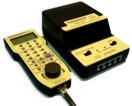 |
||||
| Prodigy Advance Digital System |
||||
| Cased Controllers |
||||
| Panel Mount Controllers |
||||
| Walkabout Controllers |
||||
| Modules & Transformers |
||||
| Scenics & Accessories |
||||
| Wiring & Electrical Components |
||||
| Tiny Signs | ||||
| Tools | ||||
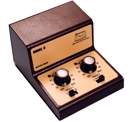 |
||||
| RECENTLY VIEWED |
| MODELSTRIP - Use GM08 |
| O Scale | Wargaming | Architectural | Narrow Gauge | Tools+ | ||
History of Eurostar

IAN FOWLER looks at the history of the route between London and the Continent.
1986 was a notable year for many reasons. In between listening to Billy Joel, Robert Palmer and Lionel Richie on your Walkman and watching Top Gun, Crocodile Dundee at the cinema or even watching Dynasty, The A Team and Neighbours on your TV, you might have also recalled the Chernobyl and Challenger disasters, Mike Tyson becoming the youngest boxing heavyweight champion in history and a certain Diego Armando Maradona and his hand of god.
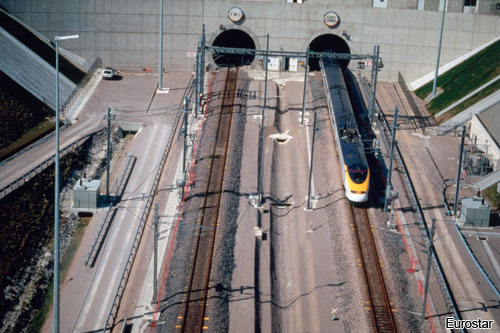
However, two significant (and diametrically opposed) transport landmarks were reached in this year as well. Firstly it was the year that the M25 orbital route was completed (OK, OK – I know TECHNICALLY the Dartford Crossing is an A Road!) and most importantly for us, it was agreed by the powers that be, that a tunnel should connect the United Kingdom with France. Of course, this wasn’t a new idea. A previous attempt in 1974 was quickly aborted with presumably the flared trousers and platform shoes of the time causing problems within the tunnel, but 1988 saw work begin again with the company Eurotunnel created to manage and own the tunnel.
Interestingly, it was decided that the tunnel would be a railway operation. There were three tunnels, one for services to the UK, one for services to France and a smaller, central service tunnel. Predominantly the tunnel would be used by shuttle trains from Folkestone to Calais, carrying cars and lorries but the lure of direct railway travel from the UK to the continent was a strong one, as was the argument for moving freight from the roads and ferries to the railway. For this reason, the then-British Rail and SNCF negotiated a deal where 50% of the tunnel capacity was made available for these purposes. Shortly after the announcement that the tunnel would become a reality, an International Project Group consisting of the UK, France and Belgium was established to specify, develop and procure the trains that would operate an international high speed service linking the UK with mainland Europe
It was fair to say that at the time, the French had significantly more experience with high speed express EMUs. The UK was still operating locomotive hauled express services on their 25kv electrified routes (overhead wires) and relatively low specification EMUs on their London & South East 750v electrified services (third rail). The decision was sensibly made to base this new train on existing TGV technology although there were both British and Belgian parts used within the trains themselves. The order was placed in 1989, and 38 French-built express EMUs were constructed to meet the needs of this exciting new express service. These trains were capable of using 25kv AC or 750v DC power to suit systems both sides of the English Channel.
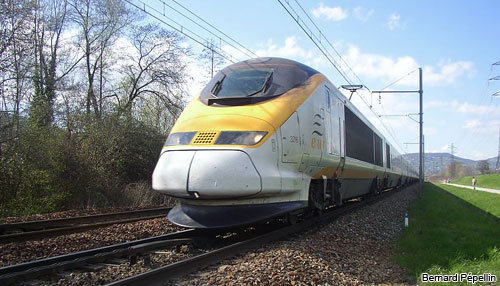
So 31 "Intercapital" sets (2 power cars with 18 coaches) and 7 "North of London" (2 power cars with 14 coaches) sets were constructed between 1992 and 1996 and were designated Class 373 in the UK and TMST (Trans Manche Super Train) in France. Eurostar have since branded the train the e300. The Intercapital sets have a capacity of 750 passengers and are 394m long. The North of London sets have a capacity of 558 passengers and are 320m long.
The trains are basically modified TGVs and can operate at 187mph on high speed lines and 100mph in the tunnel itself. Of course, they are capable of running faster but this requires special permission from the railway authorities. In fact, on 30 July 2003, a Eurostar train set a new British record of 208mph on the first section of HS1. The relatively pedestrian 99mph that these trains operate at in the tunnel itself is dictated by pathing other, slower trains within the tunnel as well as more exciting things like air and heat flow. The trains were constructed with safety in mind and for this reason are formed as two independent half sets (joined in the middle) that can, if required, be separated and driven under their own power in the event of an emergency.
27 Intercapital sets are required to fulfil the timetable so the remaining 4 sets are used by SNCF for domestic services. The numbering denotes ownership, 30xx being UK sets, 31xx are Belgian sets, 32xx are French sets and 33xx are Regional Eurostar sets.
You might be wondering about these "North of London" or "Regional Eurostar" sets. The truth is that they were a bit of a white elephant. Although the original intention was to run international services north of London to Manchester via Birmingham and to Glasgow via Newcastle, the very long journey times compared to air travel deemed these operations unviable. Three of these redundant sets were leased by GNER (the then-ECML UK train operator) for a short while to increase capacity. All of these sets now ply their trade in France for SNCF.
Despite a planned mid life refurbishment in 2008, the "refreshed" Class 373s/TMSTs didn’t enter service until late 2015. Around the same time as the announcement of the refurbishments, Eurostar entered talks with a number of suppliers about the procurement of 8 new train sets. In 2010, they announced Siemens as the preferred bidder. Alstom were unhappy at this decision and pursued several legal options, before finally accepting the decision in 2012. In late 2014, Eurostar announced that they had ordered another 7 of these e320 trains from Siemens. Some of these new e320 (Class 374) trains are in service now with the balance expecting to be in service by late 2016.
UK Eurostar services began on 14 November 1994. London’s Waterloo International was the chosen terminus at the British end and had five dedicated platforms (20-25) as well as border controls within the award-wining new station designed by Grimshaw Architects. This attractive construction features a 400m long glass and steel vault of 37 arches forming a prismatic structure with the trusses described as "banana shaped" by structural engineer Anthony Hunt. The project cost £120m.
On 8 January 1996, the UK’s second Eurostar station opened – Ashford International. Integrated into the existing Ashford station, Eurostar departures use dedicated island platforms 3 and 4 and the station provides easy access to and from nearby car parks.
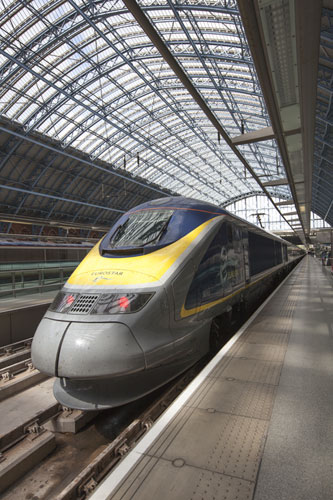
On 14 November 2007, services from London moved away from London Waterloo and to the newly refurbished 15 platform St Pancras International station which provided more convenient onward transport links. St Pancras station was extensively rebuilt between 2001 and 2007 at a cost of £800m – a mere £490m over the original estimated cost! The developers retained the charm and character of this atmospheric station and it is one of THE iconic British stations as a result. The movement and separation of Eurostar services on to a dedicated high speed line (HS1) has improved journey times and punctuality as well as increasing available paths. On a practical level, the trains now operate exclusively on 25kv AC rather than on the third rail system.
29 January 2008 saw Dame Kelly Holmes open Ebbsfleet International to Eurostar passengers. Ebbsfleet International is a conveniently placed "parkway" station with good onward transport links by road and rail.
30 November 2009 saw the opening of Stratford International – the Eurostar station that never was. The original intention was for Regional Eurostars to stop at this station on their way north, but when the concept of these services was abandoned, enthusiasm for stopping services just 7mins away from St Pancras waned despite the potential that the 2012 Olympics (held just a shot putt away) offered along with the Westfield Shopping Centre. The station is now served exclusively by South Eastern Trains Class 395 Hitachi services from St Pancras International to Kent.
These days, Eurostar run around 16 London to Paris services (10 of which are non-stop) every weekday with more on Fridays, in addition to 7 London-Lille/Brussels trains. Other destinations served include Marne la Vallee – Chessy (for Disneyland Paris), Marseille (via Lyon and Avignon) and Bourg-St Maurice, Aime-la-Plagne and Moutiers (for Alpine Skiiers).
Although encouraging noises are still made about direct rail travel into the likes of Holland and Germany, it does seem that there is interest in making this happen but it is likely to be a long process.
What is undeniable is that Eurostar remains an enjoyable and popular travel experience. Long may they continue to be successful and continue to push the boundaries of express train operation.
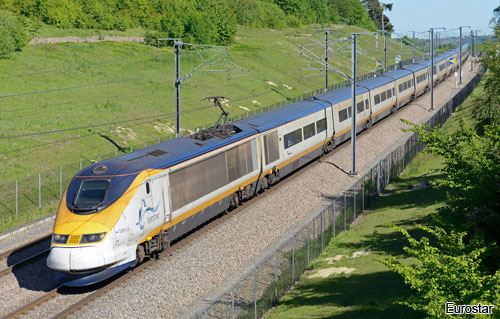
Notable Event Timeline
6 May 1994
HM The Queen opens Waterloo International before travelling on Eurostar to Calais for the Channel Tunnel inauguration with President Mitterrand of France.
14 November 1994
Eurostar start running trains to and from London Waterloo International, Paris Gare du Nord, Brussels Midi and Lille Europe.
30 July 2003
Eurostar set the UK rail speed record of 208mph (334.7kph).
17 April 2006
Eurostar launch Tread Lightly and announce that all Eurostar journeys are now carbon neutral, pledging to reduce their overall carbon emissions by 25% by 2012.
14 November 2007
St Pancras International becomes Eurostar’s new London home. The second section of the UK high speed rail line, High Speed 1, is completed. London to Paris journey times are reduced to two hours 15 minutes, and London to Brussels just one hour 51 minutes.
28 August 2009
Eurostar carry their 100 millionth traveller.
1 September 2010
The new corporate structure for Eurostar International is introduced.
7 October 2010
Eurostar announce a £700 million investment in their trains, including ten brand new ones from Siemens and the overhaul and redesign of our current fleet.
July – August 2012
As the official international rail provider to the London 2012 Olympic Games, Eurostar carry French and Belgian athletes to the London 2012 Olympic Games. Eurostar also unveil their specially adapted trains to carry French and Belgian Paralympic teams to London 2012.
31 October 2012
Eurostar announce a new Business Premier Culinary Director, the world renowned Michelin starred chef, Raymond Blanc OBE.
30 December 2013
As Eurostar enter their twentieth year, they carry our 140 millionth traveller. They also reach a record total of ten million travellers in one year.
5 June 2014
Her Majesty The Queen unveils a plaque at St Pancras to commemorate the 20th anniversary of the opening of the Channel Tunnel and Eurostar’s birthday.
13 and 14 November 2014
Eurostar celebrate their 20th anniversary by unveiling their new e320 train at St Pancras.
28 May 2015
The UK government completes the sale of its 40% share in Eurostar International Ltd to a consortium comprising Caisse de Depot et Placement du Quebec (CDPQ), and Hermes Infrastructure.
Modelling Eurostar
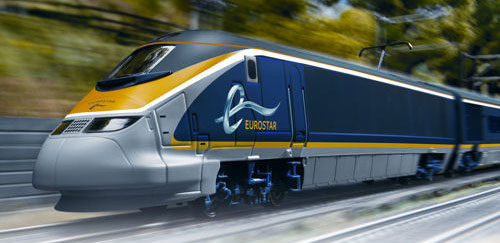
The Eurostar Class 373 is currently produced in both N and OO Scale, by Kato and Hornby respectively - as well as a version in Marklin's My World Range.
The Kato N Scale version is availble in the original Eurostar livery, and the new 2015 livery is due for release later this year. Both liveries are sold as an 8-car powered set and a 4-car extention pack. Preiser also produce a set of Eurostar Personnel in N Scale.
Hornby's OO Scale version is in the new livery, and available in a starter set as well as a train pack, with additional coach sets available.
|
We are always looking to make improvements to our website to try and improve the quality of your visit. We would welcome your feedback and suggestions, so please do not hesitate to e-mail our webmaster with your comments. Alternatively call us on 01903 884488.
Home Cookies Privacy Statement Terms & Conditions Site Map Site Guide
WEEE Regulations Glossary Careers & Jobs
Tel – +44 (0) 1903 884488 Fax – +44 (0) 1903 884377 E-Mail us – click here
Gaugemaster.com is a trading name of Gaugemaster Controls Ltd.
Registered in England No. 2714470, Registered office:
Gaugemaster House, Ford Road
Arundel, West Sussex, BN18 0BN, United Kingdom
VAT Reg. No. 587 8089 71
Copyright © 2003-2014 Gaugemaster Controls Ltd. All Rights Reserved.
















